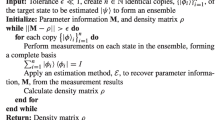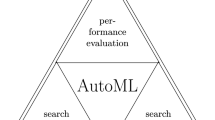Abstract
Machine learning is a crucial aspect of artificial intelligence. This paper details an approach for quantum Hebbian learning through a batched version of quantum state exponentiation. Here, batches of quantum data are interacted with learning and processing quantum bits (qubits) by a series of elementary controlled partial swap operations, resulting in a Hamiltonian simulation of the statistical ensemble of the data. We decompose this elementary operation into one and two qubit quantum gates from the Clifford+T set and use the decomposition to perform an efficiency analysis. Our construction of quantum Hebbian learning is motivated by extension from the established classical approach, and it can be used to find details about the data such as eigenvalues through phase estimation. This work contributes to the near-term development and implementation of quantum machine learning techniques.



Similar content being viewed by others
References
Aaronson S (2015) Read the fine print. Nat Phys 11(4):291
Amin MH, Andriyash E, Rolfe J, Kulchytskyy B, Melko R (2018) Quantum Boltzmann Machine. Phys Rev X 8(2):021050
Barr DS, Mani G (1998) Predictive neural network means and method for selecting a portfolio of securities wherein each network has been trained using data relating to a corresponding security. US Patent 5,761,442
Benedetti M, Realpe-Gómez J, Perdomo-Ortiz A (2018) Quantum-assisted Helmholtz machines: a quantum–classical deep learning framework for industrial datasets in near-term devices. Quantum Science and Technology 3(3):034007
Benenti G, Strini G (2010) Computing the distance between quantum channels: usefulness of the Fano representation. J Phys B Atomic Mol Phys 43:215508
Biamonte J, Wittek P, Pancotti N, Rebentrost P, Wiebe N, Lloyd S (2017) Quantum machine learning. Nature 549:195
Childs AM, Cleve R, Deotto E, Farhi E, Gutmann S, Spielman DA (2003) In: Proceedings of the thirty-fifth annual ACM symposium on Theory of computing. ACM, pp 59–68
Childs AM, Cleve R, Deotto E, Farhi E, Gutmann S, Spielman DA (2018) Toward the first quantum simulation with quantum speedup. Proc Natl Acad Sci 115(38):9456–9461
Farhi E, Neven H (2018) arXiv:1802.06002
Gilyén A, Lloyd S, Tang E (2017) arXiv:1811.04909
Giovannetti V, Lloyd S, Maccone L (2008) Quantum random access memory. Phys Rev Lett 100(16):160501
Gottesman D (2009) arXiv:0904.2557
Harrow AW, Hassidim A, Lloyd S (2009) Quantum algorithm for linear systems of equations. Phys Rev Lett 103(15):150502
Hebb DO (1949) The organization of behavior. Wiley, Hoboken
Heyfron L, Campbell ET (2017) arXiv:1712.01557
Hopfield JJ (1982) Neural networks and physical systems with emergent collective computational abilities. Proc Natl Acad Sci 79(8):2554
Kimmel S, Lin CYY, Low GH, Ozols M, Yoder TJ (2017) Hamiltonian simulation with optimal sample complexity. NPJ Quantum Inf 3(1):13
Kitaev AY (1995) arXiv:quant-ph/9511026
Lasa R, Berndt D (2007) System for rating quality of online visitors. US Patent App. 11/759,889
Liu N, Rebentrost P (2018) Quantum machine learning for quantum anomaly detection. Phys Rev A 97(4):042315
Lloyd S, Mohseni M, Rebentrost P (2014) Quantum principal component analysis. Nat Phys 10:631
MacKay DJ (2003) Information theory, inference and learning algorithms. Cambridge University Press, Cambridge
Marvian I, Lloyd S (2016) arXiv:1606.02734
McCulloch WS, Pitts W (1943) A logical calculus of the ideas immanent in nervous activity. Bull Math Biophys 5(4):115
Nielsen MA, Chuang I (2002) Quantum computation and quantum information. Cambridge University Press, Cambridge
Norris JA (1999) System and method for real time loan approval. US Patent 5,870,721
Rebentrost P, Mohseni M, Lloyd S (2014) Quantum support vector machine for big data classification. Phys Rev Lett 113(13):130503
Rebentrost P, Bromley TR, Weedbrook C, Lloyd S (2018) Quantum Hopfield neural network. Phys Rev A 98(4):042308
Ross NJ, Selinger P (2015) Optimal ancilla-free Clifford+T approximation of z-rotations. Quantum Inf Comput 15(11–12):901
Schuld M, Sinayskiy I, Petruccione F (2014) The quest for a quantum neural network. Quantum Inf Process 13(11):2567
Soklakov AN, Schack R (2006) . Phys Rev A 73(1):012307
Storkey AJ, Valabregue R (1999) The basins of attraction of a new Hopfield learning rule. Neural Netw 12(6):869
Tang E (2018) arXiv:1807.04271
Verdon G, Broughton M, Biamonte J (2017) arXiv:1712.05304
Wiebe N, Braun D, Lloyd S (2012) Quantum algorithm for data fitting. Phys Rev Lett 109(5):050505
Wiebe N, Kapoor A, Svore KM (2014) arXiv:1412.3489
Acknowledgements
We acknowledge Seth Lloyd, Iman Marvian, and George Siopsis for insightful discussions.
Author information
Authors and Affiliations
Corresponding author
Additional information
Publisher’s note
Springer Nature remains neutral with regard to jurisdictional claims in published maps and institutional affiliations.
Rights and permissions
About this article
Cite this article
Bromley, T.R., Rebentrost, P. Batched quantum state exponentiation and quantum Hebbian learning. Quantum Mach. Intell. 1, 31–40 (2019). https://doi.org/10.1007/s42484-019-00002-9
Received:
Accepted:
Published:
Issue Date:
DOI: https://doi.org/10.1007/s42484-019-00002-9




